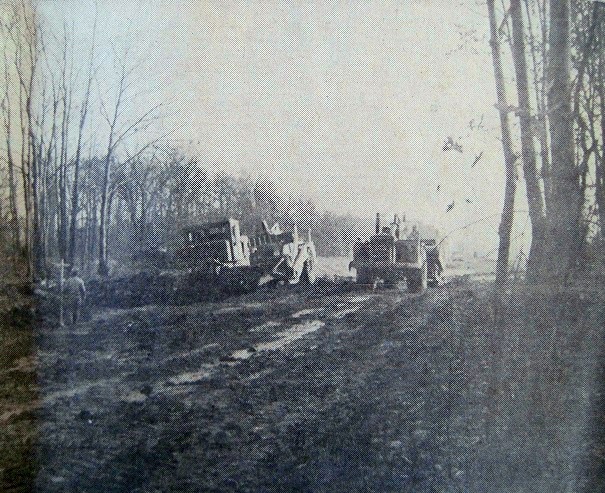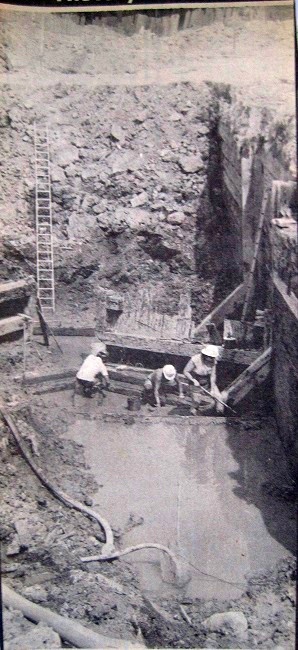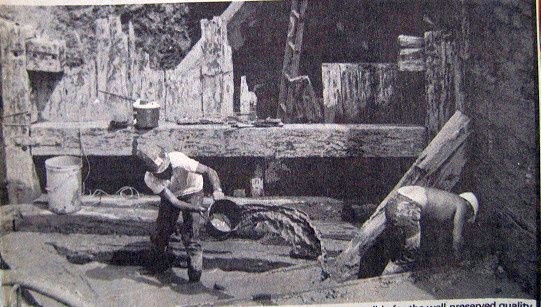Results for ‘Businesses’
124 MORE WERE IN USE THAN IN 1938, COMPANY REPORT REVEALS
[Welland Tribune, 19 February 1940]
R.D. Hughes, manager of the bell Telephone Company in Welland, has handed to The Tribune a statistical report which shows that an increase of 124 was recorded in the number of telephones in the city in 1929 compared to that of the previous year. The total number in use was 2,277 in 1938 and 2,401 in 1939.
Mr. Hughes sated that if as some authorities contended, the number of telephones in a community formed an excellent barometer of general business, than it would seem that Welland was continuing to progress from this standpoint.
Continuing, Mr. Hughes stated that offices supervised from Welland showed a net gain in the number of telephones of 284, divided as follows: Welland, 124; Port Colborne, 118; Ridgeville, 22; Smithville, 4; Wainfleet, 14; Wellandport, 2. This entire territory, he added, now had a total of 5,293 telephones in service.
Mr. Hughes showed The Tribune the Bell Telephone Company’s annual report for Ontario and Quebec, recording a total of 785,455 bell telephones in use in these two provinces at the end of the year. The records showed a net gain of 20,000 telephones compared with a net gain of 18,804 the previous year. During the year the company paid out $16,928, 825 in wages to its 9,711 employees, 5-825 in wages to its 9,711 employees, 5,008 of whom are women.
The report notes that the number of telephones recorded for 1939 is “an all- time high for Ontario and Quebec.”
[Welland Tribune, 22 October 1897]
That eligible and commodious residence on North Main street (located opposite the house of County Clerk Cooper and now occupied by lawyer Cohoe, is offered for sale at a low figure and on easy terms. The house contains about ten rooms and is a very desirable locality for a residence.
For full particulars and terms apply to A.E. Taylor, Niagara Falls, Ont., or J.B. Taylor, Welland.
[Welland Tribune February 19, 1940]
Operations On Robin Hood Plant Held Up By Weather Conditions
The heavy rain and snow of yesterday and today caused suspension of work on construction of the new R
obin Hood Flour Mills Ltd. 2,000,000 bushel grain elevator and 4,000 bag per day flour mill at Ramey’s Bend.
Lorne Sandberg, superintendent for Carter-Halls-Aldinger Co. Ltd., contractors, reported that conditions were such this morning that work could not be resumed after the weekend lay-off. Materials were being unloaded today.
At the end of the week, said Mr. Sandberg, the basement forms had been almost completed for the mill and warehouse. About 150 men employed on the work were idle as weather interrupted the construction.
[Welland Tribune February 16, 1940]
Construction Employe Goes to Hospital Suffering from Head Injuries
George Arnold, RR No. 1, Humberstone, an employe of Carter-Hallis Aldinger Co. Ltd, contractors for the new Robin Hood Flour Mills Ltd. Grain elevator and mill, suffered head injuries about 9.40 a.m. today while working on the construction, which sent him to Welland County General hospital.
Arnold suffered a cut scalp and concussion and his condition was reported at the hospital to be serious but not critical. Dr.Phyllis Black who was called to attend the injured man, said that he would be kept in the hospital for a day or two for observation. He was taken to hospital in the Dell and Merton ambulance.
Details of the accident could not be secured today, but it is reported that he was struck on the head by some falling object.
[Welland Tribune February 5, 1940]
150 Men Employed and This will be Doubled at Peak of Construction
Build Road
Workmen of the Carter-Halls-Aldinger Co. began pouring the concrete for the footings of the new 2,000,000 bushel grain elevator and 4,000 bag per day flour mill of Robin Hood Flour Mills Ltd., at Ramey’s Bend this morning. Lorne Sandberg, superintendent for the construction company announced today.
The concrete is hoisted in buckets from the huge stationary mixer up the 265 foot tower and poured at whatever level is needed. The top of the hoist tower is now at the 225 foot level but will rise another 40 feet before the work is completed.
About 150 men were employed on the construction this morning, Mr. Sandberg reported, and this number would be more than doubled shortly as the construction swung into the peak. Of the men employed the large majority were local men and this policy would be continued throughout construction, he said.
The roadway into the site north of Humberstone village on the west side of the canal from Omer avenue, is complete except for the installation of one culvert. The N.S. and T. Main spur into the site is complete and in use but the three spurs on the site off off this main spur are yet to be constructed.
[Welland Tribune January 15, 1940]
100 Men Laid off as One Unit Maple Leaf Plant Shut Down
About a hundred men were laid off by the Maple Leaf Milling Co., Ltd. At Port Colborne on Saturday as the mill resumed operation on one of the 6,000 barrel units this morning after a shut down of both units for a week. The company had been operating both units since the plant was speeded up to wartime production peak in October. About 425 are still employed in the mill, feed plant and bag company, according to Manager W.H. Cowan.
Mr. Cowan informed The Tribune this morning that the men laid off were men employed in October when the second unit was put into operation, bringing production up to the full capacity of the mill 12,000 barrels of flour per day. They had been told at the time, he said, that their work would last only as long as both units were operated.
The reason, said Mr. Cowan, was that sufficient orders could not be got through to warrant operation of both units. The second unit would remain idle, hr said, until such time as conditions adjusted themselves.
Believe this may have been from the file of George “Udy”Blazetith
DOWN MEMORY LANE
[Welland Tribune, Date Unknown]
 If you think your telephone directory is becoming somewhat cumbersome, of if you’re having trouble ripping it in half, consider the 1885 edition.
If you think your telephone directory is becoming somewhat cumbersome, of if you’re having trouble ripping it in half, consider the 1885 edition.
Welland’s first telephone directory, issued about 29 years after the county of Welland was established, listed a grand total 25 names. The Bell Telephone exchange, then located at C.J. Page’s grocery store, was open for business 12 hours a day on weekdays, 4 hours on special holidays, and 2 hours on the Sabbath. The mini-telephone book, dated December 1885, listed the following names and information as follows:
Beatty and Sons, Main St.
Beatty and Sons, Foundry, Main St.
Burgar, Dr., Office, Main St.
Burgar, J.H. Druggist, Main St.
Court House, (Sheriff’s Office) Main St.
Dexter House, E. Hoover, Prop., Main St.
Duncan, C.J., (Sheriff) Residence, Main St.
Fraser, House, F. Tuckett, Prop., Main St.
Garner, L.V., Auctioneer, Residence, Main St.
Great North-Western Telegraph Co., Main St.
Gross, J.F., Pump Manufacturer, Main St.
Harcourt and Cowper, Barristers, Main St.
Hill, J.F., Ins. Agt., Residence, Aqueduct St.
Hobson Bros., Druggists and Div. Court Office, Main St.
Imperial Bank, Muir St.
Michigan Central Railway Station, Muir St.
Page, C.J., Merchant, Main St.
Page, J.C., Dep. Registrar, Residence, Division St.
Registry Office, Main St.
Sullivan, J., (Government Contractor), Residence, Main St.
Telegraph Printing Office, Main St.
Tufts, D., Omnibus Line, Division St.
Welland House, P.W. Raymer, Prop., Main St.
Welland Station, Main St.
Williams, A. Barrister, Main St.
In the accompanying photograph, taken in 1909, a telephone line crew provided an unusual sight in those days. The modification of the skyline was one of the first steps in providing the incredible technological changes in communications of the future.
[Evening Tribune, 31 October 1964]

Heavy equipment went to work this week clearing land and putting in roadbeds for the city’s newest subdivision. Andora Park will be a 93-lot residential subdivision linking Fitch St. with the present Maple Park subdivision. General contractor for the job including roads and storm and sanitary sewers is Con-Drain Ltd. of Toronto. This will be the first subdivision by-law calling for paved roads completed under the city’s new subdivision agreement sub-divider. The above photo was taken looking south towards Fitch St.
[Welland Tribune, 1987]
 Workers complete the excavation of Lock 24 on the first Welland Canal in St. Catharines, constructed in the 1820s and discontinued in the 1840s when the second canal was built. Workers complete the excavation of Lock 24 on the first Welland Canal in St. Catharines, constructed in the 1820s and discontinued in the 1840s when the second canal was built.
The wooden canal had ships pulled through by horses and mules, and was built of wood as the most economical way of building the waterway. The first canal ended at Port Robinson where ships were locked down into the Welland River.
The excavation, carried out by the Welland Canal Conservation Authority is now completed and the lock has been re-buried under tonnes of earth to preserve it. The lock was believed to be the only one remaining of the roughly 40 locks in the first canal. |
Excavation-history in the making
By Paul Bagnell
[Welland Tribune, 4 June 1987]
ST. CATHARINES-Lock 24 is again under tonnes of earth-perhaps for good this time-but many of its secrets have been pulled forever to the surface.
The new complete excavation of Lock 24 in St. Catharines, one of those that made up the original Welland Canal, has both confirmed previously held beliefs and shed new light on the construction of the first canal.

“It was history in the making,” says John Mathot of the Welland Canals Preservation Association of the canal’s construction. The excavation project of Lock 24 has brought into clearer focus exactly how that history was made.
“Several things surprised us,” said Mathot. “One was that it was 28 feet deep, not 15 feet, as the literature tells us. Also, some of the lower portions were built with stone blocks-it was supposed to have been built all of wood.”
Also found were sluice gates in the lock’s doors. The gate allowed water to flow through the doors, taking pressure off them as they moved open or closed. Other methods could have been used to accomplish the same effect, Mathot said, and canal experts until now have had no idea which was used on the original canal.
“That was a real bonus,” Mathot said.
During the dig, about 3,000 people appeared to view the old structure.
Lock 24 measures 110 feet long and 22 feet wide. It had a lift (the vertical distance a vessel would have travelled after exiting) of ten feet and a draft (the distance between a ship’s bottom and the floor of the lock) of eight feet. It had a floor of oak planks and “cribs” used to support the wooden walls. It was built with a “tongue and groove” construction, its massive oak beams being held in place with wooden pegs.
The lock is believed to be the only one remaining from the first Welland Canal, built in the 1820s. It is thought the roughly 40 other locks were dismantled so that their oak timbers could be sold off, a theory supported by old newspaper advertisements offering them for sale.
The project was carried out by a London, Ontario firm experienced in archeological digs. A team of four archeologists and five workers used a bulldozer, a front-end loader and finally hand tools to bring the lock into view.
The threat of liability arising from accidents prevented it from being left open, said Mathot, but the sluice gate and other artifacts found-tools, bottles and pieces of pottery-will be sent to museums and a replica of the lock is planned to be constructed.
The lock has been remarkably will preserved since being buried roughly 140 years ago. A high level of underground water and the fact it was buried in clay-rich soil kept air from its huge oak beams, preventing them from decaying.
The first canal was built by the Merritt-Welland Canal Company in the 1820s. Because they were a private company, they chose wood beams as the most economical way of building the waterway. The second and third canals were built with stone blocks.
 Subscribe..
Subscribe..
 If you think your telephone directory is becoming somewhat cumbersome, of if you’re having trouble ripping it in half, consider the 1885 edition.
If you think your telephone directory is becoming somewhat cumbersome, of if you’re having trouble ripping it in half, consider the 1885 edition.
 Workers complete the excavation of Lock 24 on the first Welland Canal in St. Catharines, constructed in the 1820s and discontinued in the 1840s when the second canal was built.
Workers complete the excavation of Lock 24 on the first Welland Canal in St. Catharines, constructed in the 1820s and discontinued in the 1840s when the second canal was built.
